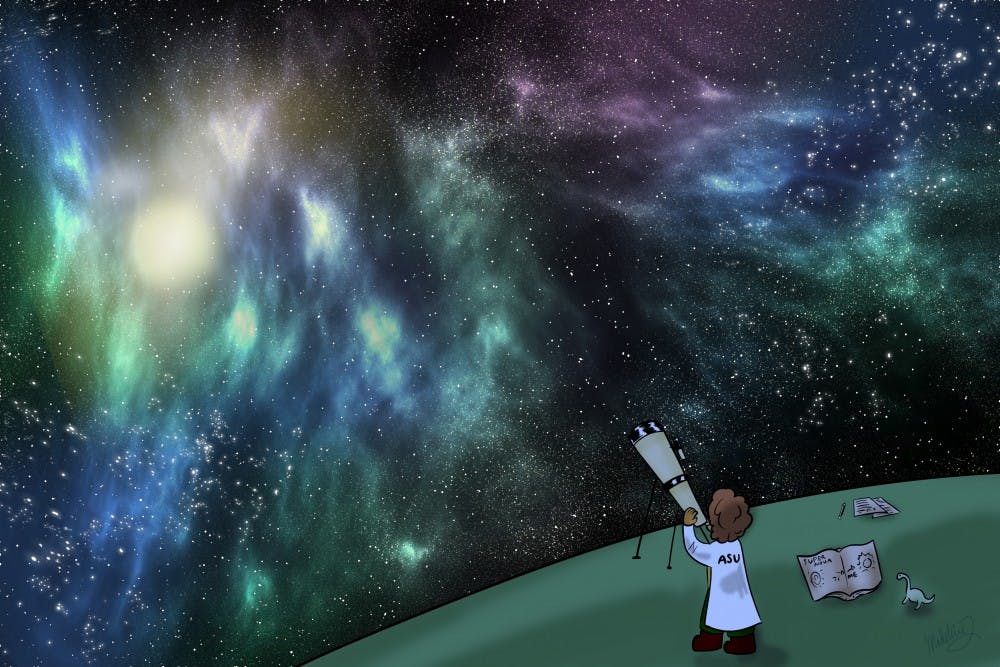Supernovae are some of the most powerful and violent phenomena in the universe. The result of a star collapsing on itself, a supernova is a massive stellar explosion. A team of researchers at ASU has made it easier to see what happens when a star explodes.
Theoretical astrophysicist and associate professor for the ASU School of Earth and Space Exploration Patrick Young and a team of graduate students created some of the most comprehensive simulations of supernovae remnants to date.
Young presented the project at the Marston Exploration Theater at the Interdisciplinary Science and Technology Building IV at the end of August.
Attendees viewed the team's simulations with 3D glasses, giving viewers a chance to peer through a supernova's depths.
According to Young, a supernova releases the light of a hundred billion suns. Supernovae fling their enriched elements across the universe, and those elements then become the source of new stars and planets.
To better understand supernovae, Young and his team created simulations of a supernova by inputting the data of a theoretical star into supercomputers and letting the star virtually explode.
Rotating view of a supernova approximately 20 days after explosion
Young said the project’s objective was to compare the computer models of supernovae remnants with observations of real supernovae in the universe.
“The goal of the research was to use observations of the remnants of supernovae explosions in the recent past to test our understanding of the mechanisms of supernovae explosions by comparing it with our models,” Young said.
Simulations of supernovae explosions are not new, but Young said his project is the first to predict the remnants and materials coming from a supernova decades into the future.
“The unique thing that we’re doing is taking the explosions out to much later in the evolution," Young said. "We’re transitioning from the supernova itself to the supernova remnants.”
Young discovered that elements ejected into space by a real supernova, Cassiopeia A, closely matched the results of his supernova simulation.
“We’ve noticed some features in the distribution of stuff that bares a lot of similarities to brand new observations of Cassiopeia A,” Young said. “It really was looking at the 3D visualizations that we realized ‘oh this is something that people have not reproduced before and got kind of a cool result'.”
Young said that the process of creating a computer visual of an exploding star presented a new way to look at the data and led to new directions in the research.
“It is really hard to take a look at the numbers that come out and understand anything, but the human brain is really good at interpreting visual data and looking at the simulations,” Young said.
Graduate student Gregory Vance is one of the research team members. Vance finds the work to be a unique topic of study.
“I tell people at parties that I blow up stars on computers and look at the pieces,” Vance said.
Development of structures in the explosion of a red supergiant star fifteen times the mass of the sun
He says that supernovae are not only vital to life on earth, but also to most elements.
“Supernovae are really the forge for all the heavy elements in the universe that we need for life and the formation of planets and other cool things like you and I,” Vance said.
Former Ph.D research associate at ASU, Carola Ellinger, worked with Young to create the visualizations.
Ellinger said that when working on the simulation, she wanted to help create something new rather than rehash old work.
"I didn't want to just reproduce something that has already published. I wanted to produce something new," Ellinger said. "One of the things that very few authors have done ... that I have done is to keep track of the different elemental abundances of chemical elements in different layers of the star, where they end up after the explosion."
Ellinger said seeing the data in 3D after working on the simulation was a special experience.
“It's hard to imagine how it would look like in 3D and then actually seeing it," Ellinger said. "It was pretty mind blowing.”
The team is continuing to research the appearance of elements, primarily titanium-44, to link elements in our solar system to supernovae.
Visuals courtesy of Patrick Young.
Reach the reporter at cscragg@asu.edu or follow @monsoonchaser on Twitter.
Like State Press on Facebook and follow @statepress on Twitter.





